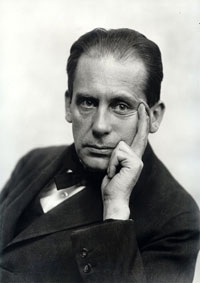Biography
Walter Gropius, like his father and his great-uncle Martin Gropius before him, studied to became an architect. Gropius could not draw, and was dependent on collaborators and partner-interpreters throughout his career. In school he hired an assistant to complete his homework for him. In 1908, after studying architecture in Munich and Berlin for four semesters, Gropius joined the office of the renowned architect and industrial designer Peter Behrens, one of the first members of the utilitarian school.[3] His fellow employees at this time included Ludwig Mies van der Rohe and Le Corbusier.
Early Career
In 1910 Gropius left the firm of Behrens and together with fellow employee Adolf Meyer established a practice in Berlin. Together they share credit for one of the seminal modernist buildings created during this period: the Faguswerk in Alfeld-an-der-Leine, Germany, a shoe last factory. Although Gropius and Meyer only designed the facade, the glass curtain walls of this building demonstrated both the modernist principle that form reflects function and Gropius's concern with providing healthful conditions for the working class. The factory is now regarded as one of the crucial founding monuments of European modernism.
World War I
Walter Gropius was drafted August 1914 and served as a sergeant and then as a lieutenant in the signal corps on the Western front in the First World War. He survived being both buried under rubble and dead bodies, and shot out of the sky with a dead pilot. He was awarded the Iron Cross twice.
Bauhaus
Gropius's career advanced in the postwar period. Henry van de Velde, the master of the Grand-Ducal Saxon School of Arts and Crafts in Weimar was asked to step down in 1915 due to his Belgian nationality. His recommendation for Gropius to succeed him led eventually to Gropius's appointment as master of the school in 1919. It was this academy which Gropius transformed into the world famous Bauhaus, attracting a faculty that included Paul Klee, Johannes Itten, Josef Albers, Herbert Bayer, László Moholy-Nagy, Otto Bartning and Wassily Kandinsky. In principle, the Bauhaus represented an opportunity to extend beauty and quality to every home through well designed industrially produced objects. The Bauhaus program was experimental and the emphasis was on theory.
Late Career in United States
The rise of Hitler in the 1930s drove Gropius out of Germany. With the help of the English architect Maxwell Fry, Gropius was able to leave Nazi Germany in 1934, on the pretext of making a temporary visit to Italy for a film propaganda festival; he then fled to Britain to avoid the fascist powers of Europe. He lived and worked in Britain, as part of the Isokon group with Fry and others and then moved on to the United States with his family. The house the Gropiuses built for themselves in Lincoln, Massachusetts in 1938, now known as Gropius House, was influential in bringing International Modernism to the U.S. Helen Storrow, a banker's wife and philanthropist, became Gropius's benefactor when she invested a portion of her land and wealth for the architect's home. She was so satisfied with the result that she gave more land and financial support to four other professors, two of whom Gropius designed homes for. With the Bauhaus philosophy in mind, every aspect of the homes and their surrounding landscapes were planned for maximum efficiency and simplicity. Gropius’s house received a huge response and was declared a National Landmark in 2000.
Gropius and his Bauhaus protégé Marcel Breuer both moved to Cambridge, Massachusetts, to teach at the Harvard Graduate School of Design (1937-1952) and collaborate on projects including The Alan I W Frank House in Pittsburgh and the company-town Aluminum City Terrace project in New Kensington, Pennsylvania, before their professional split. In 1938 Gropius was appointed chairman of the Department of Architecture, a post he held until his retirement in 1952. In 1944, he became a naturalized citizen of the United States.
In 1946, he founded the young architects’ association, The Architects' Collaborative (TAC), a manifestation of his lifelong belief in the significance of teamwork, which he had already successfully introduced at the Bauhaus. Based in Cambridge, TAC's team included Norman C. Fletcher, Jean B. Fletcher, John C. Harkness, Sarah P. Harkness, Robert S. MacMillan, Louis A. MacMillen, and Benjamin C. Thompson. One work produced by this office was the Graduate Center of Harvard University in Cambridge (1949/50). TAC would become one of the most well-known and respected architectural firms in the world before closing in 1995.
One of the last buildings Gropius contributed to was the PanAm building (now the MetLife building) in New York, 1960-63. Built in the International Style, at the time it was the largest office building in the world by square footage. It is convenient to but towers over Grand Central Station.
Gropius died in 1969 from lung congestion following surgery.
